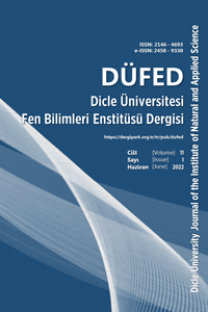Atmalı DC saçtırma ile hazırlanan Cr/n-Si Schottky engel diyotunun seri direnç ve arayüzey durum yoğunluğu özellikleri
The series resistance and the interface state density properties of a Cr/n–Si Schottky barrier diode prepared by pulsed DC sputtering
Pulsed DC sputtering, Schottky diode Series resistance, Interface state density, Barrier height,
___
1. A. Maestrini, B. Thomas, H. Wang, C. Jung, J. Treuttel, Y.Jin, G. Chattopadhyay, I. Mehdi, G. Beaudin, C. R. Physique 11 (2010) 480–495.2. M.K. Hudait, K.P. Venkateswarlu, S.B. Krupanidhi, Solid State Electron 45 (2001) 133-141.
3. M. Soylu, F. Yakuphanoglu, Thin Solid Films 519 (2011) 1950–1954.
4. S. Asubay, O. Gullu, A. Turut, Vacuum 83 (2009) 1470–1474.
5. E.H. Rhoderick, R.H.Williams, Metal– Semiconductor Contacts, Oxford, Clerendon, 1988.
6. W. Mönch, J. Vac. Sci. Technol. B 17 (1999) 1867- 1876.
7. S. Chand, S. Bala, Phys B 390 (2007) 179-184.
8. C. Nuhoglu, Y. Gulen, Vacuum 84 (2010) 812–816.
9. S. Karatas, A. Turut, Physica B 381 (2006) 199–203.
10. S. Alt›ndal, I. Yucedag, A. Tataroglu, Vacuum 84 (2010) 363–368.
11. B. Sahin, H. Cetin, E. Ayyildiz, Solid State Commun. 135 (2005) 490–495. 12. O Pakma, N Serin, T Serin, S Alt›ndal, Semicond. Sci. Technol. 23 (2008) 105014-105022.
13. G. Guler, Ö. Gullu, Ö.F. Bakkaloglu, A. Turut, Physica B 403 (2008) 2211–2214.
14. Y.S. Ocak, M.F. Genisel, T. Kilicoglu, Microelectron. Eng. 87 (2010) 2338–2342.
15. B. Tatar, A.E. Bulgurcuo¤lu, P. Gökdemir, P. Aydogan, D. Y›lmazer, O. Özdemir, K. Kutlu, Int. J. Hydrogen Energy 34 (2009) 5208–5212.
16. W.T. Yen, Y.C. Lin, P.C. Yao, J.H. Ke, Y.L. Chen, Appl. Surf. Sci 256 (2010) 3432–3437.
17. Y.C. Lin, J.Y. Li, W.T. Yen, Appl. Surf. Sci. 254 (2008) 3262-3268.
18. S.K. Cheung, N.W. Cheung, Appl. Phys. Lett. 49 (1986) 85-87.
19. H. Norde, J. Appl. Phys. 50 (1979) 5052-5053.
20. O. Pakma, N.Serin, T.Serin, S. Alt›ndal, Physica B 406 (2011) 771–776.
21. H.C. Card, E.H. Rhoderick, J. Phys. D 4 (1971) 1589-1601.
22. M.K. Hudait, S.B. Kruppanidhi, Solid State Electron 44 (2000) 1089-1097.
23. E.H. Nicollian, J.R. Brews, MOS (Metal–Oxide– Semiconductor) Physics and Technology, Wiley, New York, 1982.
24. A. Turut, N. Yalcin, M. Saglam, Solid State Electron 35 (1992) 835.
25. S. Aydogan, U. Incekara, A.R. Deniz, A. Turut, Microelectronic Engineering 87 (2010) 2525-2530.
26. B. Akkal, Z. Benamara, B. Gruzza, L. Bideux, Vacuum 57 (2000) 219-228.
27. M.Okutan, E. Basaran, F. Yakuphanoglu, Appl. Surf. Sci. 252 (2005) 1966–1973.
28. S. Aydo¤an, U. Incekara, A. Turut, Thin Solid Films 518 (2010) 7156–7160.
- ISSN: 2146-4693
- Yayın Aralığı: Yılda 2 Sayı
- Başlangıç: 2012
- Yayıncı: Dicle Üniversitesi
İki çekirdekli rutenyum II aren komplekslerinin ketonların transfer hidrojenasyonuna uygulanması
Nermin MERİÇ, Cezmi KAYAN, Murat AYDEMİR, Yusuf Selim OCAK, Akın BAYSAL, Hamdi TEMEL
Prevalence of house dust mites in houses, hotels and student dormitories of Diyarbakır province
Medeni AYKUT, Ömer Köksal ERMAN, Salih DOĞAN
NaCl -BaCl2 -H2O üçlü su-tuz sisteminin +50o'de incelenmesi
İhsan ALACABEY, Vedat ADIGÜZEL, Arzu YENİGÜN, Vedat TAVŞAN, Ali Rıza KUL, İhsan ALACABEY
Hamdi TEMEL, Hasan UÇMAK, Salih PAŞA, Mustafa A. YILMAZ, Salih HOŞOĞLU
Cezmi KAYAN, Nermin MERİÇ, Murat AYDEMİR, Akın BAYSAL, Hamdi TEMEL
